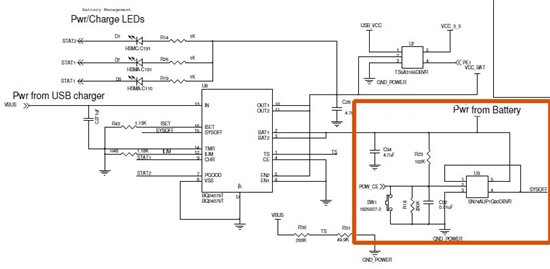Hi,
The problem is with the BQ24079T charging a LiIon (and powering a small circuit) from 5.0V USB input.
With no battery plugged in, but USB 5.0V applied to the BQ the CHG LED lights (i.e. CHG* goes low).
I have a small circuit that is always powered (to toggle a flip flop with a NO momentary switch).
Hence, there is always a wee bit of current draining the battery (and, apparently, if there is not a battery!)
This wee current is drained by a SN74AUP1G80 flip-flop which uses about 10 uA of current. As it turns out the flip-flop input cannot handle the max 4.1V from the LiIon so I had to put a voltage divider on the D input amounting to 302 kOhm, which could draw another 4.1v/302k = 14uA. It ~seems~ like my circuit (attached) would only draw a small amt of current, perhaps 24 uA.
Note: I wasn't happy with drawing this much current continuously and wanted to eliminate the divider, so I went to flip-flop SN74LVC1G80 that could withstand the 4.1V and eliminated the divider thereby drawing even ~less~ current, but still the little CHG LED stays on like some hollow little demon eye staring me down! ;-)
I see that the battery detection current for the BQ24079T, IBAT(DET) , is a minimum of 5mA and a maximum of 10mA (p. 5 of data sheet), so why would the CHG stay low drawing such little current?
The kicker is I can attach the battery and the CHG light goes out after it charges! But as soon as I pull the battery, the CHG LED comes back on!
I thought I might be reading the flip-flop data sheets wrong and they are drawing more current (most likely answer), but the CHG does go out when the battery is fully charged.
Any advice?
Thanks in advance,


